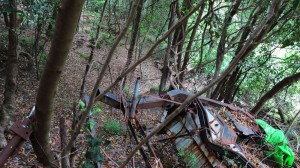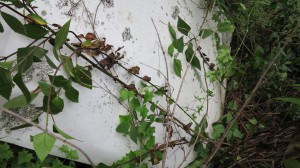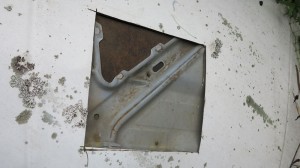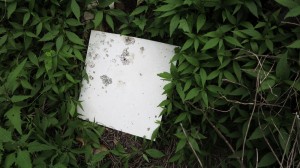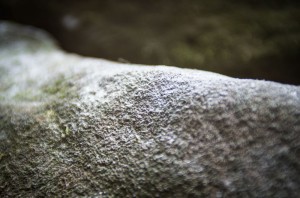Of course it is not possible to look at the Sun directly. The source of light itself – generally, specifically and in every sense – can not itself become an object of view.
It can only be regarded askance.
So I will approach the Sun through a selection of Sun writings – not heliographs or even photographs, but written meditations on the nature of the Sun.
Since these notes are in orbit, since they represent a circling around the topic, I can describe the initial set of writings here.
Thales, the first of the Pre-Socratic philosophers, predicts a solar eclipse in 585BC that halts the battle between the Medians and the Lydians. This story is almost certainly apocryphal, but it links the beginning of Western philosophy to reflection upon the intercession of cosmic events within the space of human affairs. The Sun appears for reflection precisely as it withdraws, as it engages with a theatre of light’s suspension – its obscuring and passage into darkness.
Heraclitus recognises fire and flux as the principle of all things and yet regards the Sun as no larger than a human foot. It is a small bowl passing above the Earth each day, which rises, burns and declines with the exhalations of the Earth. Heraclitus describes then the Sun’s intimate relation to the Earth, but has no means of comprehending the scale of the Sun – a burning that exceeds any variety of terrestial flame.
Anaximander, on the other hand, who actually precedes Heraclitus, is the first to theorise the vast size of the Sun, yet this somehow leads to a neglect of its immediate heat. Suddenly recognised as an immense thing that exists at an immense distance from the Earth, the Sun grows increasingly abstract. Prior to the Sun, prior to any specific thing, Anaximander describes the apeiron, the indefinite. I am drawn to this view – this sense of everything arising from the indefinite and ultimately returning to it – but what is the relation between the indefinite and the experience of the real – let us say, the light of the Sun? How can the indefinite and the notion of the Sun be thought together? As a play of light, as warmth on the skin, or the experience of cold? As all of this, but without anything so specific? There seems a need to imagine an inexpressible experience of the Sun, summoning neither subject nor object, distance or proximity. Beyond the interaction of Sun, natural world and senses, there is the need to conceive a zone of experience/existence that precedes (or possibly exceeds or proceeds from) all categories.
This next reference is less immediatedly sunny. I want to say something about Parmenides‘s threshold – the key mythopoetic conceit that provides the basis for his determination of the primary, singular, undifferentiated nature of being. In his prologue, Parmenides describes being transported across the firmament on a chariot to the gates that separate day from night. Here the godesses, daughters of the Sun, teach him that there is only being and not nothing and that everything is one. So once again we find something like the liminal zone of an eclipse, which obtains its force precisely in terms of playing upon and unsettling fields of difference (dark and light). That it should be this more complex, irreducible space that provides the basis for recognising and asserting a primordial unity seems interesting/paradoxical.
At the end of Plato‘s parable of the cave, the freed prisoner makes his way out of the cave (the space of illusion) to discover the blinding light of the Sun. Initially he longs to retreat to the cave. Only gradually does he develop the capacity to regard sunlight and the Sun itself directly, which appears as a metaphor for the realm of pure forms – of ideal truth. Here then, the heat of the Sun, the actual basis of its capacity to blind, the process of nuclear fusion, for example, that 20th century science will discover transforms hydrogen into helium, slips away to the side. The Sun is regarded as form of pure light, of pure intelligibility, that touches only at an ideal level (as an immaterial harbinger of truth).
In his three volume, Philosophy of Nature, Hegel argues that the light of the Sun bears no relation to the terrestrial flame. It is not an actual burning. It is a purely ideal light that pours forth with no need for fuel and that imparts no heat whatsoever. The proof, he argues, is that the air is cooler on high mountains than in valleys – altitudinal proximity to the Sun does nothing to increase temperature (ignoring, of course, how latitude affects climate). While this can only seem bizarre to us now, it is important to note that Hegel was not a scientific illiterate. On the contrary, he was very well acquainted with the science of his day. What it does demonstrate is a deep attachment to an idealist metaphysics and to the notion of the Sun’s ideal distance from nature proper and from the material human realm specifically. The Sun becomes indicative of the gap between ideality and materiality. Can we imagine anything like this now? Now that that cosmological events have become so immediate? Now that the time of the Sun plainly intersects with historical time?
It may also be worth revisiting Nietzsche‘s The Birth of Tragedy, with its distinction between Appolo and Dionysos, between the Apollonian light of representation, illusion and art and the Dionysian darkness of dance, music and intoxication. Appolo is closely associated with Helios, the Titan god of the Sun, and within this schema the Sun is positioned on the side of formal order, reflective visibility and rational consciousness. Even here then, even within the context of the work of a philosopher who is passionately opposed to the heritage of idealism (to Kant and Hegel specifically) there is conception of the Sun as lofty, austere and ultimately immaterial.
Dissident Surrealist, Georges Bataille, resists all this. In articles such as “Solar Anus” and “Rotten Sun” he insists that solar illumination represents not a calm, self-contained light, but rather a filthy, hot explosion of matter. In its heat, horror and blindness, it represents the summit of rational being in other terms, not as absolute knowledge but as a spewing forth – an “expenditure without reserve”. Yet this parodic inversion of the idealist metaphorics still cannot avoid casting the Sun in humanly, poetically sensible terms. To regard the Sun in terms of the logic of excess, abandon and horror is, at least to some extent, to humanise it. Perhaps?
Then there is Maurice Blanchot‘s short story, “The Madness of the Day”, in which trajectories of blindness and insight become indissoluably entwined. The work suggests a kind of Dionysian sunlight of the soul, in which every effort to see and to clarify is itself a motion of abandon and loss.
I should probably also discuss Jaques Derrida‘s “White Mythology”, which includes a detailed examination of the metaphor of the the Sun within western philosophy – particularly in terms of questioning the possibility of grounding this metaphor in any kind of notion of immediate experience, any kind of intimate experience of the Sun. Instead the metaphor appears as an instance of catachresis – of imposed relation, of criminal usury, of passage away from any hope of authentic, original meaning. So where, however, does this leave the Sun and the experience of the Sun? Where does this leave the Earth and its rising temperatures? To imagine the baseless autonomy of the human field of meaning – its endless deferral from consequence – is also to project a time in which the Sun – the spectre of the Sun – is placed yet again at an infinite distance.
And finally, perhaps, I would like to say something about the contemporary speculative realist position, which would no doubt describe the Sun as a kind of object, perhaps a metaobject. It would grant the Sun’s its presence and its impenetrable autonomy; it cannot be known exhaustively, it does not depend on our seeing it to exist. Yet cast as an object – as the integrity of an object – we risk losing the sense of our complex, indefinite, real and mediated relation to it. We risk nominalising the phenomenon – losing sense of the alterity, intimacy and elusiveness of the Sun. We risk imagining that we can stand back from the Sun and describe its contours. It is not as an object that we confront the Sun, but as a profound, inescapable, awkwardly and impossibly bounded conceptual and experiential space.
The Sun is the very problem of the present, of recognising the present and acknowledging its demands.

